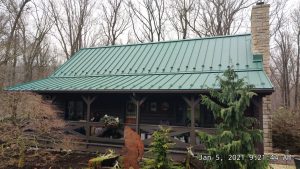
In the past few years, metal roofing has grown in popularity as more and more people discover the benefits of metal roofing over asphalt shingles. Metal is resilient, standing up to weather extremes, wildfires, and hurricanes. For the environmentally conscious, it’s also an earth-friendlier choice – 100% recyclable and made in part with recycled materials. Metal roofing also lowers cooling costs by reflecting UV rays, keeping the home cooler.
Two popular types of metal roofing are standing seam and corrugated metal. Both are durable and attractive options that come in a variety of materials, sizes, patterns, and colors to match your home. But what’s the difference?
Here is a look at the pros and cons of each type.
Standing Seam Roofing
Standing seam roofing is a system of metal panels with raised seams connected with hidden fasteners.
Standing seam pros
Standing seam roofing is one of the most durable options available and has many benefits:
Longer lasting
At 24-26 gauge, standing seam panels are thicker than most corrugated metal panels. They typically stand up better to severe weather and don’t bend in high wind. Because the panels are typically not pinned, standing seam panels can expand and contract with temperature changes, reducing wrinkling, noise, and fastener withdrawal.
Stylish, attractive design
Standing seam panels are generally considered more attractive than corrugated panels, with a more streamlined look. Standing seam installations tend to have sleeker lines and are more common than corrugated systems in high-end projects.
Lots of color options
Standing seam panels come in different profiles, sizes, shapes, thickness, and colors. Standing seam systems are easy to match with your structure because they can come in nearly any color, including custom colors.
Hidden fasteners mean less leaking
Hidden fasteners of standing seam systems don’t penetrate the metal panels and are concealed below the surface of the panel using clip or nail flange systems. This keeps the fasteners protected from the elements, making the panels more watertight than corrugated metal panels. This system is especially suitable in situations with longer panel lengths (25 feet or more).
Standing seam cons
There are few downsides to standing seam roofing:
More expensive
While this type of roofing has higher upfront costs, the lifetime cost is significantly less than that of shingles or even corrugated metal. It’s the most expensive of the metal panel options, costing up to twice the amount of asphalt shingle or corrugated metal roofing. However, the cost reflects the quality, longevity, and aesthetics of the roofing. The cost per project varies based on factors like roof complexity and pitch, material gauge, and color.
More technical installation
Installation of standing seam roofing is more complex than other types of roofing. Thus, installation costs around 50% more than corrugated roofing, and it can be challenging to find a qualified contractor. Repairs are also time-consuming, as panels need to be separated to replace them.
Corrugated Metal Roofing
One of the first types of designed metal roofing, corrugated metal roofing has been used around the world for many years.
Corrugated metal pros
Corrugated metal roofing is durable and affordable. It has similar benefits to other types of metal roofing:
Affordable
Corrugated metal is the most affordable type of metal roofing and is similar in pricing to asphalt shingles. Corrugated metal typically costs 50% less than standing seam metal roofing. Installation is also quicker and more affordable, as it generally is easier to install than standing seam.
Energy-saving benefits of metal
Like other metal roofing types, corrugated metal roofing is partially made from recycled materials and is recyclable. It’s a more sustainable and eco-friendly option than asphalt shingles. It can also be coated to reflect heat rather than absorb it, decreasing cooling costs.
Lots of color options
Like other types of metal roofing, corrugated panels come in different sizes, patterns, thickness, and colors. Panels can be painted a variety of colors to match the structure.
Corrugated metal cons
Corrugated metal is less durable than standing seam roofing. Some disadvantages are:
Leak potential
The biggest drawback to corrugated metal roofing is its potential to leak. The fasteners and seams are exposed to the elements and can wear out, causing leaks. Even when perfectly installed, fluctuating temperatures from season to season can loosen screws, allowing moisture to seep in.
Shorter lifespan
The potential for leaks means corrugated metal isn’t as durable as standing seam roofing. It also typically requires more maintenance and doesn’t last as long.
Metal roofing doesn’t usually need maintenance, but corrugated metal roofing should be inspected yearly to verify that fasteners are still tight.
Less sophisticated look
Corrugated metal panels have exposed screws that may not look as sleek or upscale as standing seam roofing. It’s typically considered a less sophisticated-looking roofing option.
Choosing the Right Roof
Both standing seam and corrugated metal roofing have considerable benefits over asphalt shingle roofing, but your specific needs will guide your choice. In general:
Standing seam roofing may be best for people who:
- Are concerned about maintenance
- Have a lower-sloped roof
- Live in areas with potential for severe weather
- Want a modern look
- Are willing to spend more for quality and weather resistance
Corrugated metal roofing may be best for people who:
- Prefer to spend less
- Like a wavy look, not flat
- Plan to install their roof themselves
- Want panels that are easier to work with
Whichever option you choose, you can be assured that metal roofing is a long-lasting, durable, and attractive option for your property. Our experts are available to answer your questions about metal roofing and help you choose the best roof for your needs.
Pennsylvania Home Improvement Contractor License (HIC) # PA124258

